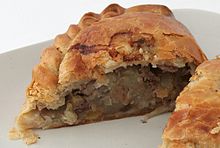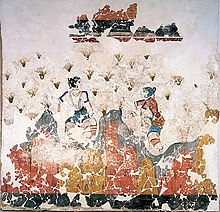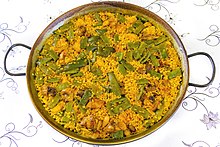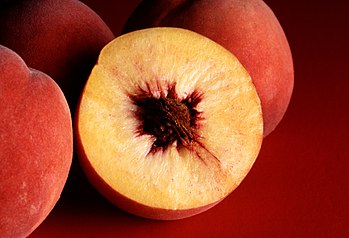F o o d
A portal dedicated to food and foodways
Introduction


Food is any substance consumed by an organism for nutritional support. Food is usually of plant, animal, or fungal origin and contains essential nutrients such as carbohydrates, fats, proteins, vitamins, or minerals. The substance is ingested by an organism and assimilated by the organism's cells to provide energy, maintain life, or stimulate growth. Different species of animals have different feeding behaviours that satisfy the needs of their metabolisms and have evolved to fill a specific ecological niche within specific geographical contexts.
Omnivorous humans are highly adaptable and have adapted to obtain food in many different ecosystems. Humans generally use cooking to prepare food for consumption. The majority of the food energy required is supplied by the industrial food industry, which produces food through intensive agriculture and distributes it through complex food processing and food distribution systems. This system of conventional agriculture relies heavily on fossil fuels, which means that the food and agricultural systems are one of the major contributors to climate change, accounting for as much as 37% of total greenhouse gas emissions. (Full article...)
Cooking, also known as cookery or professionally as the culinary arts, is the art, science and craft of using heat to make food more palatable, digestible, nutritious, or safe. Cooking techniques and ingredients vary widely, from grilling food over an open fire, to using electric stoves, to baking in various types of ovens, reflecting local conditions. Cooking is an aspect of all human societies and a cultural universal.
Preparing food with heat or fire is an activity unique to humans. Archeological evidence of cooking fires from at least 300,000 years ago exists, but some estimate that humans started cooking up to 2 million years ago.
The expansion of agriculture, commerce, trade, and transportation between civilizations in different regions offered cooks many new ingredients. New inventions and technologies, such as the invention of pottery for holding and boiling of water, expanded cooking techniques. Some modern cooks apply advanced scientific techniques to food preparation to further enhance the flavor of the dish served. (Full article...)
Palestinian cuisine consists of foods from or commonly eaten by Palestinians, whether in Palestine, Israel, Jordan, or refugee camps in nearby countries, or by the Palestinian diaspora. The cuisine is a diffusion of the cultures of civilizations that settled in the region of Palestine, particularly during and after the Islamic era beginning with the Arab Ummayad conquest, then the eventual Persian-influenced Abbasids and ending with the strong influences of Turkish cuisine, resulting from the coming of the Ottoman Turks. It is similar to other Levantine cuisines, including Lebanese, Syrian and Jordanian.
Cooking styles vary, and types of cooking style and ingredients used are generally based on the climate and location of the particular region and on traditions. Rice and variations of kibbee are common in the Galilee. The West Bank engages primarily in heavier meals involving the use of taboon bread, rice and meat, and coastal plain inhabitants frequent fish, other seafood, and lentils. The Gaza cuisine is a variation of the Levant cuisine, but is more diverse in seafood and spices. Gaza's inhabitants heavily consume chili peppers too. Meals are usually eaten in the household but dining out has become prominent particularly during parties where light meals like salads, bread dips and skewered meats are served. (Full article...)
Selected article –
Veganism is the practice of abstaining from the use of animal products—particularly in diet—and an associated philosophy that rejects the commodity status of animals. A person who practices veganism is known as a vegan.
The foundations of veganism include ethical, moral, environmental, health and humanitarian arguments. Veganism excludes all animal use, for example in food (meat, fish, eggs, milk and dairy products, honey), in clothing and industry (leather, wool, fur and some cosmetics), entertainment (zoos, exotic pets, circuses), or services (guide dogs, police dogs, hunting dogs, working animals, or animal testing, including medical experimentation). (Full article...)Selected cuisine -

Cornish cuisine encompasses the cooking styles, traditions and recipes associated with Cornwall and the Cornish people. It has been heavily influenced by the geography of the county as well as its social history.
Cornwall, being a peninsula surrounded by seas historically well-stocked with fish, has meant that fish dishes form a major part of the historical and modern recipes in Cornwall. The fishing industry has played a major part in the economy of the county. The iconic dish of Cornwall, the pasty, has its roots in another historical industry within the county, this being mining. (Full article...)Selected ingredient –

Cornmeal is a meal (coarse flour) ground from dried corn (maize). It is a common staple food and is ground to coarse, medium, and fine consistencies, but it is not as fine as wheat flour can be. In Mexico and Louisiana, very finely ground cornmeal is referred to as corn flour. When fine cornmeal is made from maize that has been soaked in an alkaline solution, e.g., limewater (a process known as nixtamalization), it is called masa harina (or masa flour), which is used for making arepas, tamales, and tortillas. Boiled cornmeal is called polenta in Italy and is also a traditional dish and bread substitute in Romania. (Full article...)
Selected recipe –
Paella (/paɪˈɛlə/, /pɑːˈeɪjə/, py-EL-ə, pah-AY-yə, Valencian: [paˈeʎa]; Spanish: [paˈeʝa]) is a rice dish originally from the Valencian Community. Paella is regarded as one of the community's identifying symbols. It is one of the best-known dishes in Spanish cuisine.
The dish takes its name from the wide, shallow traditional pan used to cook the dish on an open fire, paella being the word for a frying pan in Valencian/Catalan language. As a dish, it may have ancient roots, but in its modern form, it is traced back to the mid-19th century, in the rural area around the Albufera lagoon adjacent to the city of Valencia, on the Mediterranean coast of Spain. (Full article...)

Human cultivation and use of saffron spans more than 3,500 years and extends across cultures, continents, and civilizations. Saffron, a spice derived from the dried stigmas of the saffron crocus (Crocus sativus), has through history remained among the world's most costly substances. With its bitter taste, hay-like fragrance, and slight metallic notes, the apocarotenoid-rich saffron has been used as a seasoning, fragrance, dye, and medicine.
The wild precursor of domesticated saffron crocus was likely Crocus cartwrightianus, a plant native to mainland Greece, Euboea, Crete, Skyros and some islands of the Cyclades. This species has been used as a wild source of saffron. A study reported in 2019 that the authors considered that a cross between two cytotypes of Crocus cartwrightianus was responsible for the emergence of Crocus sativus. This was probably a unique or very rare event as there is no genetic diversity in commercial saffron today. Another study in 2019 showed that a population of Crocus cartwrightianus near Athens in Attica was the closest match to the theoretical ancestors of Crocus sativus. (Full article...)Selected image –
Selected biography –
MFK Fisher
B. July 3, 1908 – d. June 22, 1992
Mary Frances Kennedy Fisher Parrish Friede (July 3, 1908 – June 22, 1992), writing as M.F.K. Fisher, was an American food writer. She was a founder of the Napa Valley Wine Library. Over her lifetime she wrote 27 books, including a translation of Brillat-Savarin's The Physiology of Taste. Fisher believed that eating well was just one of the "arts of life" and explored this in her writing. W. H. Auden once remarked, "I do not know of anyone in the United States who writes better prose." In 1991 the New York Times editorial board went so far as to say, "Calling M.F.K. Fisher, who has just been elected to the American Academy and National Institute of Arts and Letters, a food writer is a lot like calling Mozart a tunesmith." (Full article...)
Did you know (auto-generated) –

- ... that Gleaners Food Bank has served more than 700 million pounds (320 million kg) of food in Indiana?
- ... that food stylist Susan Spungen estimated that she baked hundreds of pies with Josh Brolin and film staff while practicing for a scene in Labor Day?
- ... that food psychology research has found that the COVID-19 pandemic led to both reduced and increased consumption of junk food among different geographical populations and educational backgrounds?
- ... that on July 11, 2022, millions of dollars worth of jewelry was stolen from the back of a truck while one driver was getting food at a California truck stop and the other one was asleep in the cab?
- ... that a New York pop-up restaurant opened by Louisa Shafia served stews and rice dishes described in a review as a "Persian-tapas gateway into the ancient cuisine"?
- ... that food YouTuber Mike Chen also runs a channel documenting strange phenomena?
More did you know –
Related portals
Food topics
The following are topics relating to food
Categories
Food list articles
- See also: Lists of foods and Category:Lists of drinks
The following are some Food list articles on Wikipedia:

- American cheeses
- Appellation d'Origine Contrôlée cheeses
- Apple cultivars
- Bacon dishes
- Bacon substitutes
- Basil cultivars
- Breads
- Breakfast beverages
- Breakfast cereals
- Breakfast foods
- British cheeses
- Cakes
- Candies
- Cheeses
- Cheese soups
- Christmas dishes (list)
- Cocktails
- Cookies
- Dishes using coconut milk
- Diets
- Doughnut varieties
- Egg dishes
- Fermented soy products
- Food additives
- Food additives (Codex Alimentarius)
- Foods named after people
- French cheeses
- French dishes
- Fried dough foods
- Fruits
- List of hamburgers
- Herbs and spices
- Hors d'oeuvre
- Indian dishes
- Indian snack foods
- Indonesian dishes
- Italian dishes
- Japanese snacks
- Japanese dishes
- Jewish dishes
- Kebabs
- Korean beverages
- Mango cultivars
- Moroccan dishes
- Pasta
- Pastries
- Philippine snack food
- Pies, tarts and flans
- Poppy seed pastries and dishes
- Potato dishes
- Puddings
- Raw fish dishes
- Rice dishes
- Rolled foods
- Sauces
- Seafood
- Seeds
- Sandwiches
- Snack foods
- Soft drinks by country
- Soul foods and dishes
- Soups
- Stews
- Street foods
- Tapas
- Turkish dishes
- Twice-baked foods
- Vegetable oils
- Vegetables
- Vodkas
Things you can do
Related WikiProjects
| Parent project: WikiProject Food and Drink | |
| Child projects: | Task forces: (All inactive) |
|
|
| Related projects: | |
New articles
Rules | Match log | Results page (for watching) | Last updated: 2024-08-04 19:19 (UTC)
Note: The list display can now be customized by each user. See List display personalization for details.
- Lexington Barbecue (edit | talk | history | links | watch | logs | tools) by Another Believer (talk · contribs · new pages (55)) started on 2024-08-04, score: 10
- Jeon Ha-young (edit | talk | history | links | watch | logs | tools) by Adamtt9 (talk · contribs · new pages (88)) started on 2024-08-03, score: 10
- Ambpoeial (edit | talk | history | links | watch | logs | tools) by Hangshangs (talk · contribs · new pages (2)) started on 2024-08-03, score: 30
- Adriano Go (edit | talk | history | links | watch | logs | tools) by YssaLang (talk · contribs · new pages (66)) started on 2024-08-03, score: 10
- Lucy's (bar) (edit | talk | history | links | watch | logs | tools) by 9t5 (talk · contribs · new pages (15)) started on 2024-08-02, score: 10
- Premna microphylla (edit | talk | history | links | watch | logs | tools) by Awkwafaba (talk · contribs · new pages (113)) started on 2024-08-02, score: 10
- Hutaoli (edit | talk | history | links | watch | logs | tools) by AirQuinn (talk · contribs · new pages (2)) started on 2024-08-02, score: 10
- Poinpy (edit | talk | history | links | watch | logs | tools) by Gisrhgver (talk · contribs · new pages (2)) started on 2024-08-01, score: 20
- Coat of arms of Sudbury (edit | talk | history | links | watch | logs | tools) by WikiPhil012 (talk · contribs · new pages (6)) started on 2024-08-01, score: 10
- Daiwa House Premist Dome (edit | talk | history | links | watch | logs | tools) by SoftReverie (talk · contribs · new pages (0)) started on 2024-08-01, score: 10
- Chin Mee Chin Confectionery (edit | talk | history | links | watch | logs | tools) by Imbluey2 (talk · contribs · new pages (9)) started on 2024-08-01, score: 10
- Prince Edward County wine (edit | talk | history | links | watch | logs | tools) by Abatishchev (talk · contribs · new pages (1)) started on 2024-08-01, score: 10
- Heinrich Bennecke (edit | talk | history | links | watch | logs | tools) by Historybuff0105 (talk · contribs · new pages (9)) started on 2024-07-31, score: 10
- Schwartauer Werke (edit | talk | history | links | watch | logs | tools) by Theanonymoustypist (talk · contribs · new pages (6)) started on 2024-07-23, score: 20
- Sudhir Sastry (edit | talk | history | links | watch | logs | tools) by HRShami (talk · contribs · new pages (11)) started on 2024-07-31, score: 10
- Izze (drink) (edit | talk | history | links | watch | logs | tools) by Atubofsilverware (talk · contribs · new pages (5)) started on 2024-07-31, score: 30
- Carmona Wine Urn (edit | talk | history | links | watch | logs | tools) by NeverBeGameOver (talk · contribs · new pages (2)) started on 2024-07-31, score: 10
- Moisés Gómez (baseball) (edit | talk | history | links | watch | logs | tools) by Stonecold415 (talk · contribs · new pages (10)) started on 2024-07-31, score: 10
- Thiere (edit | talk | history | links | watch | logs | tools) by Monomi0 (talk · contribs · new pages (2)) started on 2024-07-30, score: 10
- Quest Nutrition (edit | talk | history | links | watch | logs | tools) by BanjoZebra (talk · contribs · new pages (6)) started on 2024-07-19, score: 20
- Food shaming (edit | talk | history | links | watch | logs | tools) by GobsPint (talk · contribs · new pages (25)) started on 2024-07-30, score: 10
- Tottiford, Kennick, and Trenchford Reservoirs (edit | talk | history | links | watch | logs | tools) by Owain.davies (talk · contribs · new pages (9)) started on 2024-07-29, score: 10
- Bryan Sammons (edit | talk | history | links | watch | logs | tools) by Muboshgu (talk · contribs · new pages (14)) started on 2024-07-29, score: 10
- Hy (company) (edit | talk | history | links | watch | logs | tools) by FrederickEvans (talk · contribs · new pages (88)) started on 2024-07-29, score: 20
- Masterfoods (edit | talk | history | links | watch | logs | tools) by Pidzz (talk · contribs · new pages (15)) started on 2024-07-29, score: 40
- Hydrox Corporation (edit | talk | history | links | watch | logs | tools) by Bluethricecreamman (talk · contribs · new pages (2)) started on 2024-07-29, score: 30
- Marmelada de Santa Luzia (edit | talk | history | links | watch | logs | tools) by BaduFerreira (talk · contribs · new pages (2)) started on 2024-07-28, score: 30
- Mangifera applanata (edit | talk | history | links | watch | logs | tools) by Tropwine (talk · contribs · new pages (5)) started on 2024-07-28, score: 10
- Avec (restaurant) (edit | talk | history | links | watch | logs | tools) by Another Believer (talk · contribs · new pages (55)) started on 2024-07-26, score: 10
- Oh Seung-hoon (curler) (edit | talk | history | links | watch | logs | tools) by TracyFleuryFan (talk · contribs · new pages (14)) started on 2024-07-27, score: 10
- Neary's (edit | talk | history | links | watch | logs | tools) by Voorts (talk · contribs · new pages (21)) started on 2024-07-27, score: 10
- Phin (restaurant) (edit | talk | history | links | watch | logs | tools) by Another Believer (talk · contribs · new pages (55)) started on 2024-07-27, score: 10
- Parliamentary Under-Secretary of State for Nature (edit | talk | history | links | watch | logs | tools) by THeShavidow1 (talk · contribs · new pages (16)) started on 2024-07-27, score: 10
- T. B. Robson (edit | talk | history | links | watch | logs | tools) by Doug butler (talk · contribs · new pages (15)) started on 2024-07-27, score: 10
- Nepal Foods (edit | talk | history | links | watch | logs | tools) by HibaShaikh (talk · contribs · new pages (1)) started on 2024-07-27, score: 10
- Analog Coffee (edit | talk | history | links | watch | logs | tools) by Another Believer (talk · contribs · new pages (55)) started on 2024-07-27, score: 10
- The Green Tree Distillery (edit | talk | history | links | watch | logs | tools) by MonikaKubasakova (talk · contribs · new pages (1)) started on 2024-07-27, score: 10
- Café Hagen (edit | talk | history | links | watch | logs | tools) by Another Believer (talk · contribs · new pages (55)) started on 2024-07-23, score: 10
- Mannion v. Coors Brewing Co. (edit | talk | history | links | watch | logs | tools) by Daniel Case (talk · contribs · new pages (6)) started on 2024-07-25, score: 10
- Meldon Reservoir (edit | talk | history | links | watch | logs | tools) by Owain.davies (talk · contribs · new pages (9)) started on 2024-07-24, score: 10
- Pendennis Club (cocktail) (edit | talk | history | links | watch | logs | tools) by Nbarth (talk · contribs · new pages (5)) started on 2024-07-24, score: 10
- Lewis Orford (footballer) (edit | talk | history | links | watch | logs | tools) by 86.18.110.36 (talk · contribs · new pages (1)) started on 2024-07-24, score: 10
- Hags (restaurant) (edit | talk | history | links | watch | logs | tools) by MainlyTwelve (talk · contribs · new pages (13)) started on 2024-07-23, score: 10
- Angelito Esguerra (edit | talk | history | links | watch | logs | tools) by YssaLang (talk · contribs · new pages (66)) started on 2024-07-23, score: 10
- Moon Si-woo (edit | talk | history | links | watch | logs | tools) by TracyFleuryFan (talk · contribs · new pages (14)) started on 2024-07-23, score: 10
- Kim Ji-yoon (curler) (edit | talk | history | links | watch | logs | tools) by TracyFleuryFan (talk · contribs · new pages (14)) started on 2024-07-22, score: 10
- Tavern Talk (edit | talk | history | links | watch | logs | tools) by CoffeeTalkBarista (talk · contribs · new pages (2)) started on 2024-07-21, score: 20
- Martha Brotherton (edit | talk | history | links | watch | logs | tools) by Throughthemind (talk · contribs · new pages (13)) started on 2024-07-22, score: 10
- Bellwether Bar (edit | talk | history | links | watch | logs | tools) by Another Believer (talk · contribs · new pages (55)) started on 2024-07-21, score: 10
- Candyland (Brooke Candy album) (edit | talk | history | links | watch | logs | tools) by BiggestBidder (talk · contribs · new pages (1)) started on 2024-07-21, score: 10
- Dovyalis affra (edit | talk | history | links | watch | logs | tools) by Sminthopsis84 (talk · contribs · new pages (8)) started on 2024-07-20, score: 10
Associated Wikimedia
The following Wikimedia Foundation sister projects provide more on this subject:
-
Commons
Free media repository -
Wikibooks
Free textbooks and manuals -
Wikidata
Free knowledge base -
Wikinews
Free-content news -
Wikiquote
Collection of quotations -
Wikisource
Free-content library -
Wikiversity
Free learning tools -
Wiktionary
Dictionary and thesaurus














































